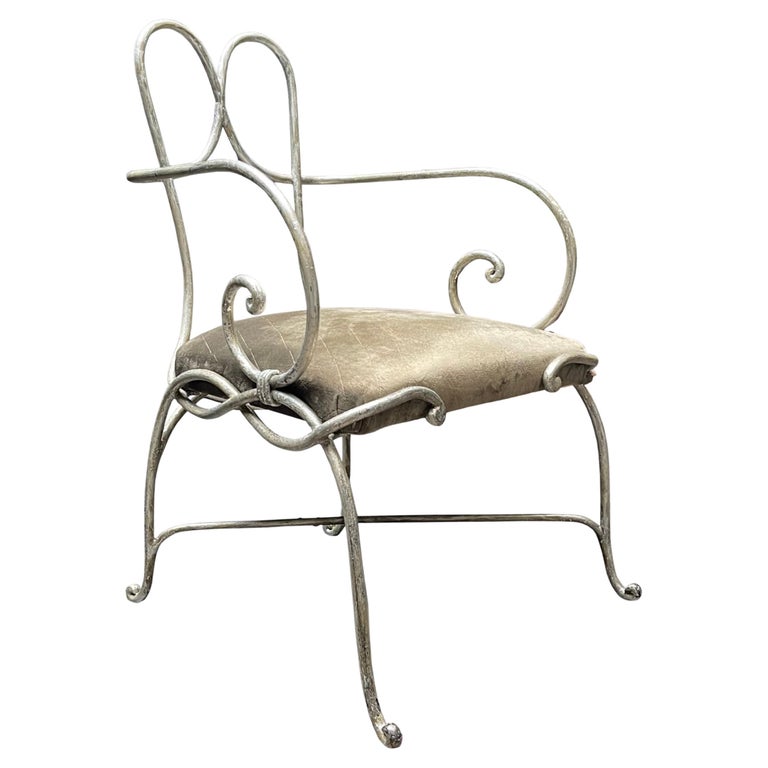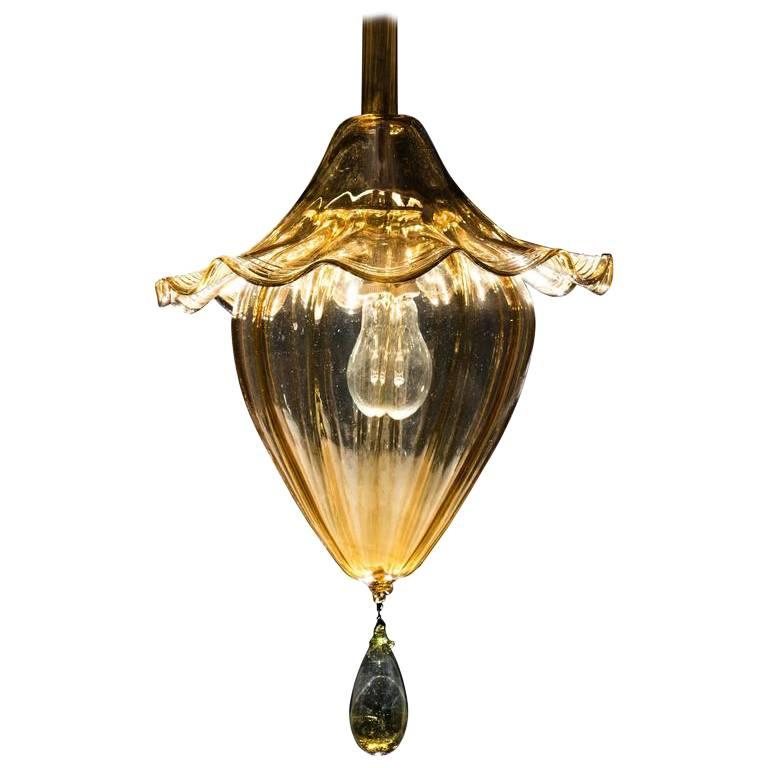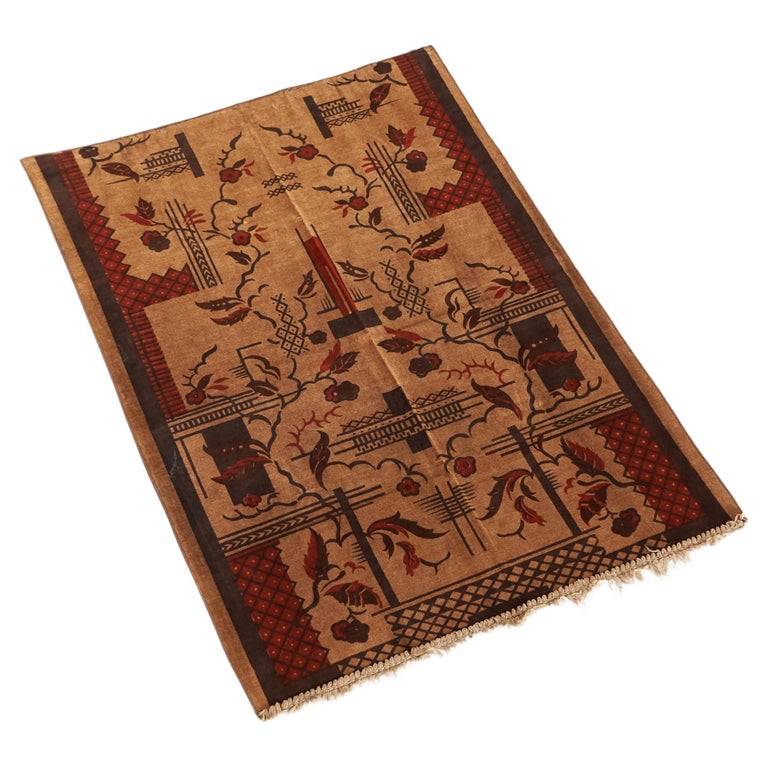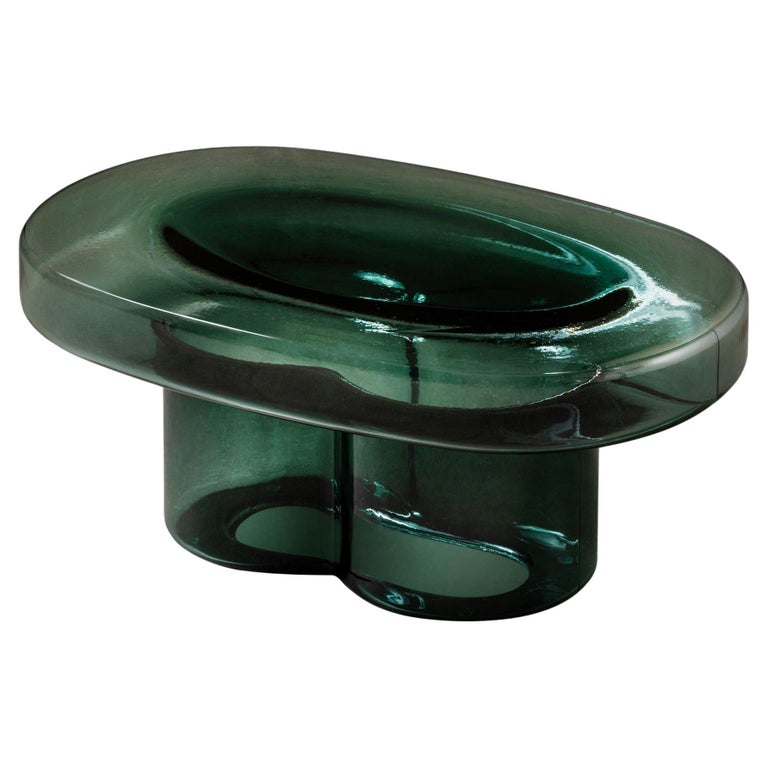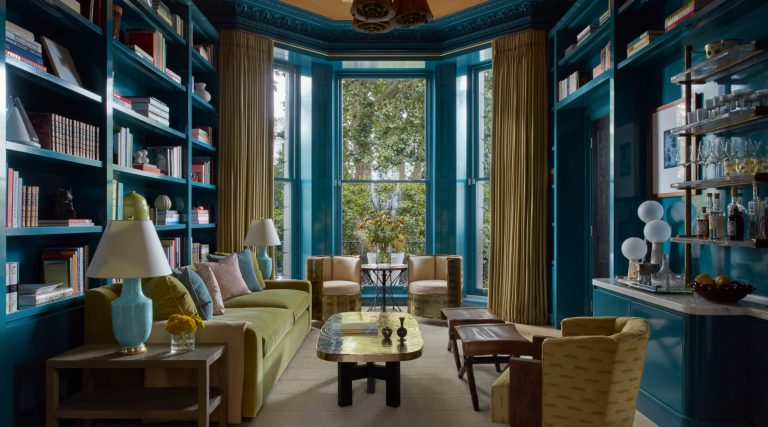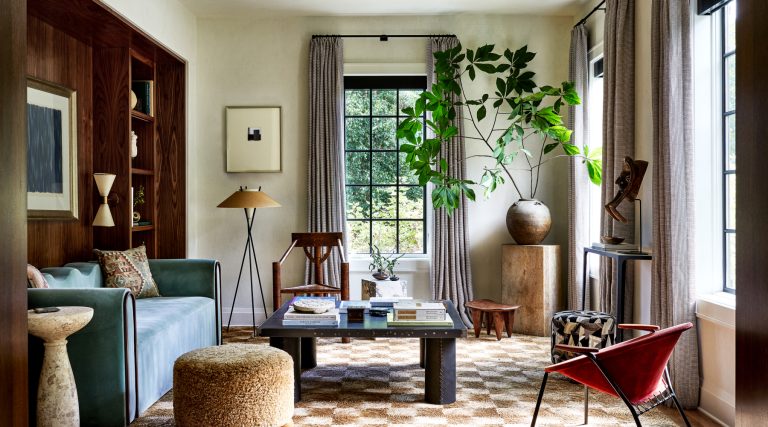March 16, 2025A couple of years after Blair Moore launched her interiors firm, Moore House Design, in New York City, the tumult surrounding COVID prompted her to reassess. Seeking a lifestyle change, she picked up and relocated to Warren, Rhode Island, a historic port town outside Providence that is near some of her family.
“I was like, I’m moving. If my team follows me, great,” says Moore, who grew up on a cattle farm in Australia. “Some of my team did follow me, and we built our firm up here. Plus, I get to spend a lot of time on the water, on boats, which I really like.”
Moore has clients across the country, from Boston to Charleston to Telluride, but when it comes to projects in coastal New England, she believes her firm offers an especially distinctive approach.
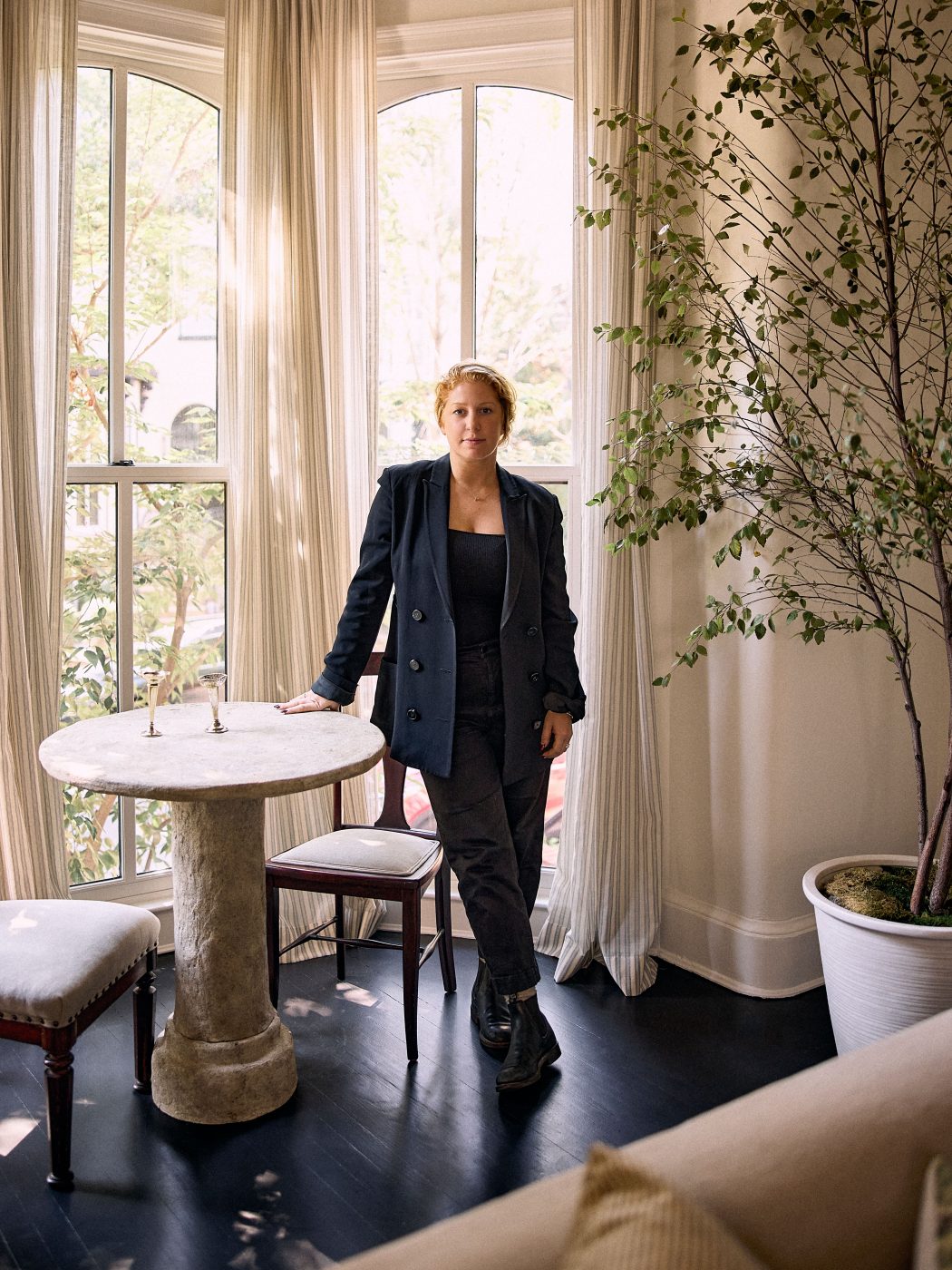
“We don’t do a lot of the white shiplap, beachy blue spaces you find here,” she says. “Our spaces use a lot of vintage, a lot of antiques, a lot of texture.”
That emphasis on history and character is what caught the attention of a couple building their retirement dream house on a narrow waterfront parcel in Jamestown, Rhode Island. Construction had already begun on the residence, designed by local firm Dimauro Architects, when they reached out to Moore about overseeing the interior decoration.
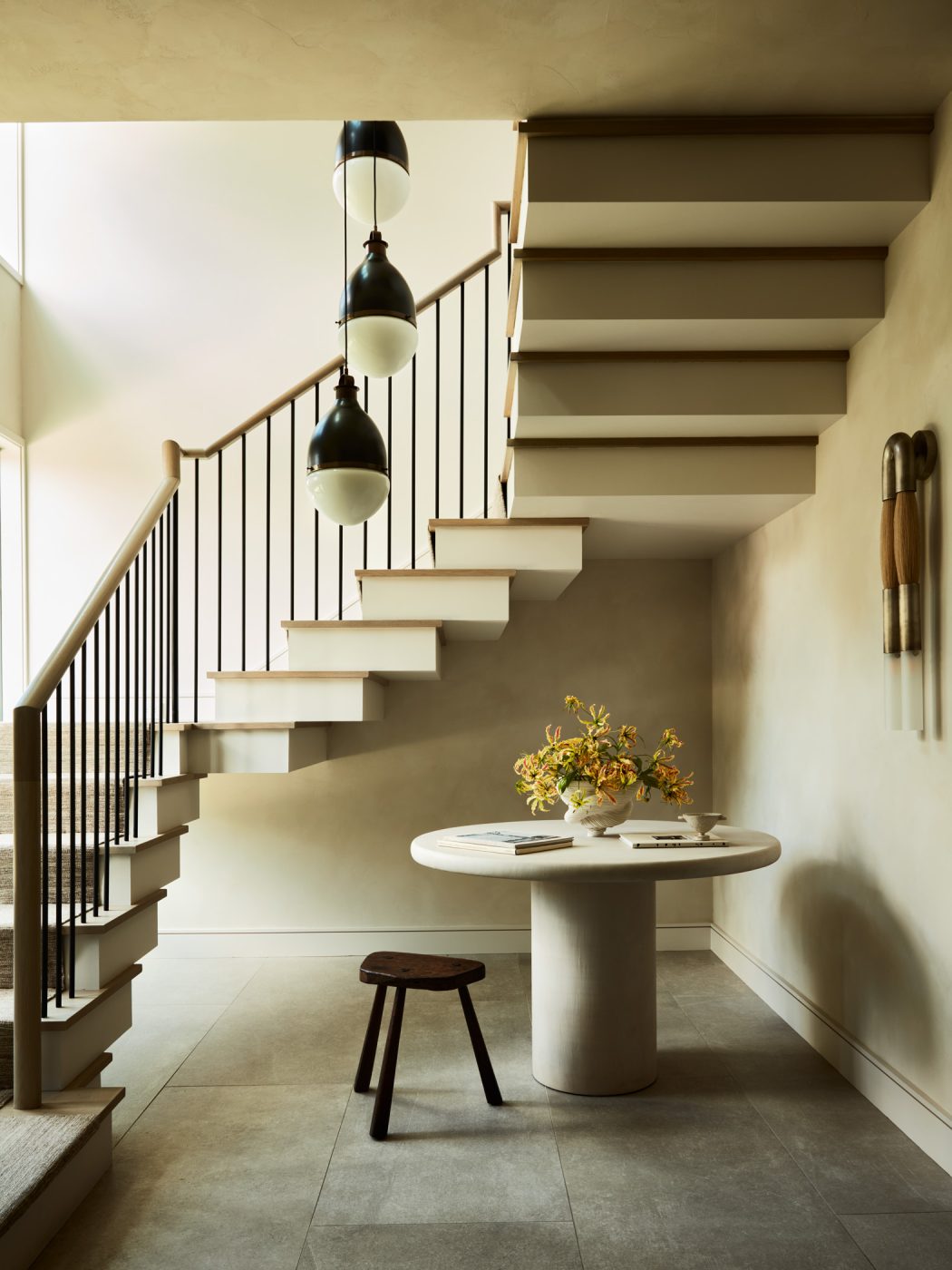

The 5,500-square-foot dwelling — described by Moore as “modern Tudor,” owing to its historically inspired exterior architectural details — has three bedrooms in the main house, plus two more in a standalone guest cottage. A sprawling multilevel rear terrace, bordered by gardens devised by Connecticut-based Artemis Landscape Architects, affords stunning views of Narragansett Bay.
“There are parts of Jamestown where it almost looks like the Mediterranean, with rocky cliffs and formations and all of these little coves,” says Moore. “Everything was really about bringing the outside in.”
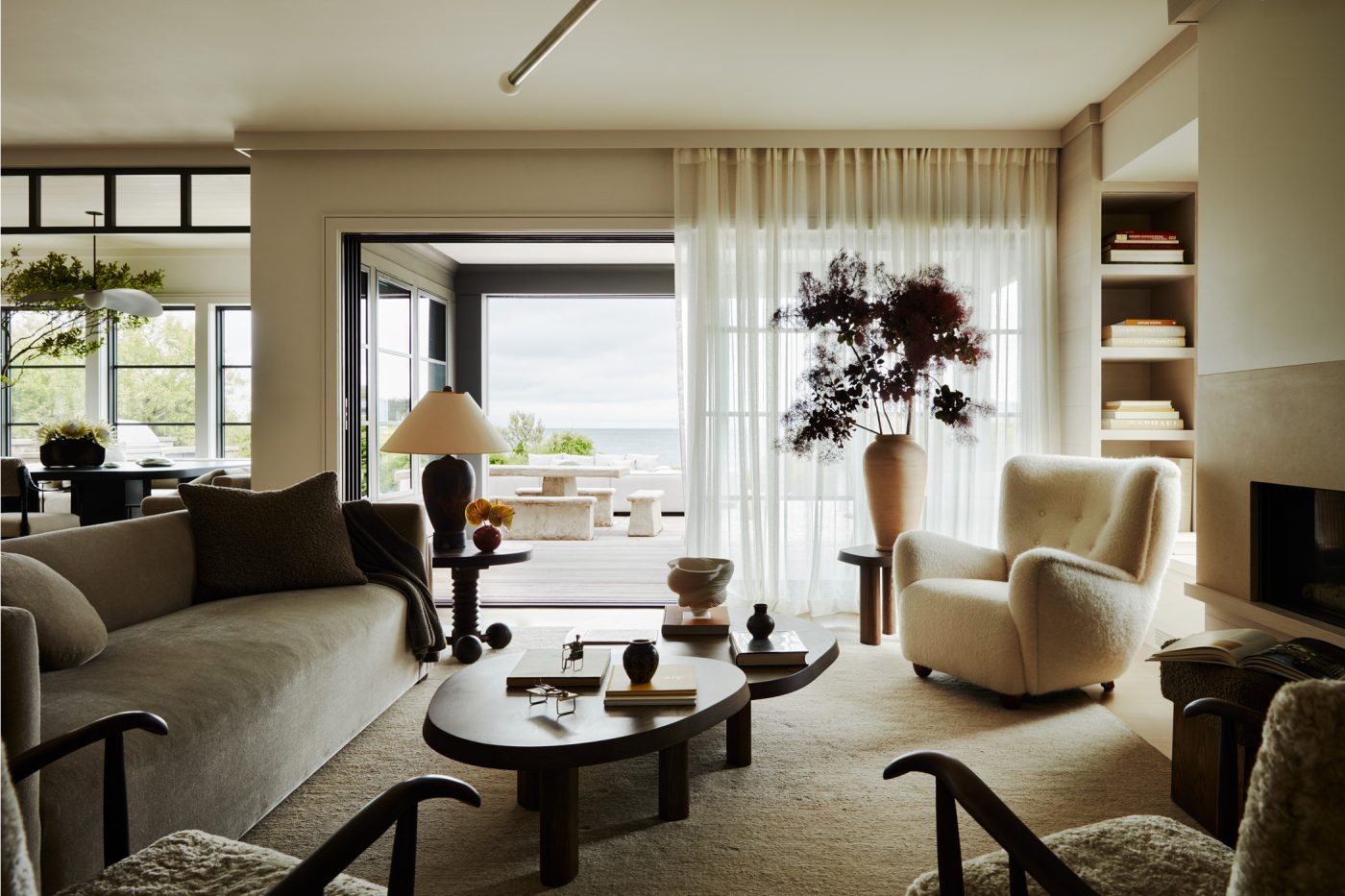
Making the most of the views, expanses of glass line the water-facing rooms, starting with the ground-floor entertaining spaces, which flow seamlessly into one another and open directly onto the terrace.
Just above, on the second floor, is the primary suite, and the top floor contains his and her retreats, which Moore tailored as a home office for the husband and what they dubbed a “sacred space” for the wife. “It’s where she does meditation, sound baths, yoga and she keeps her collection of healing crystals,” explains the designer, who describes the wife as “a very cool, spiritual, quirky gal.”
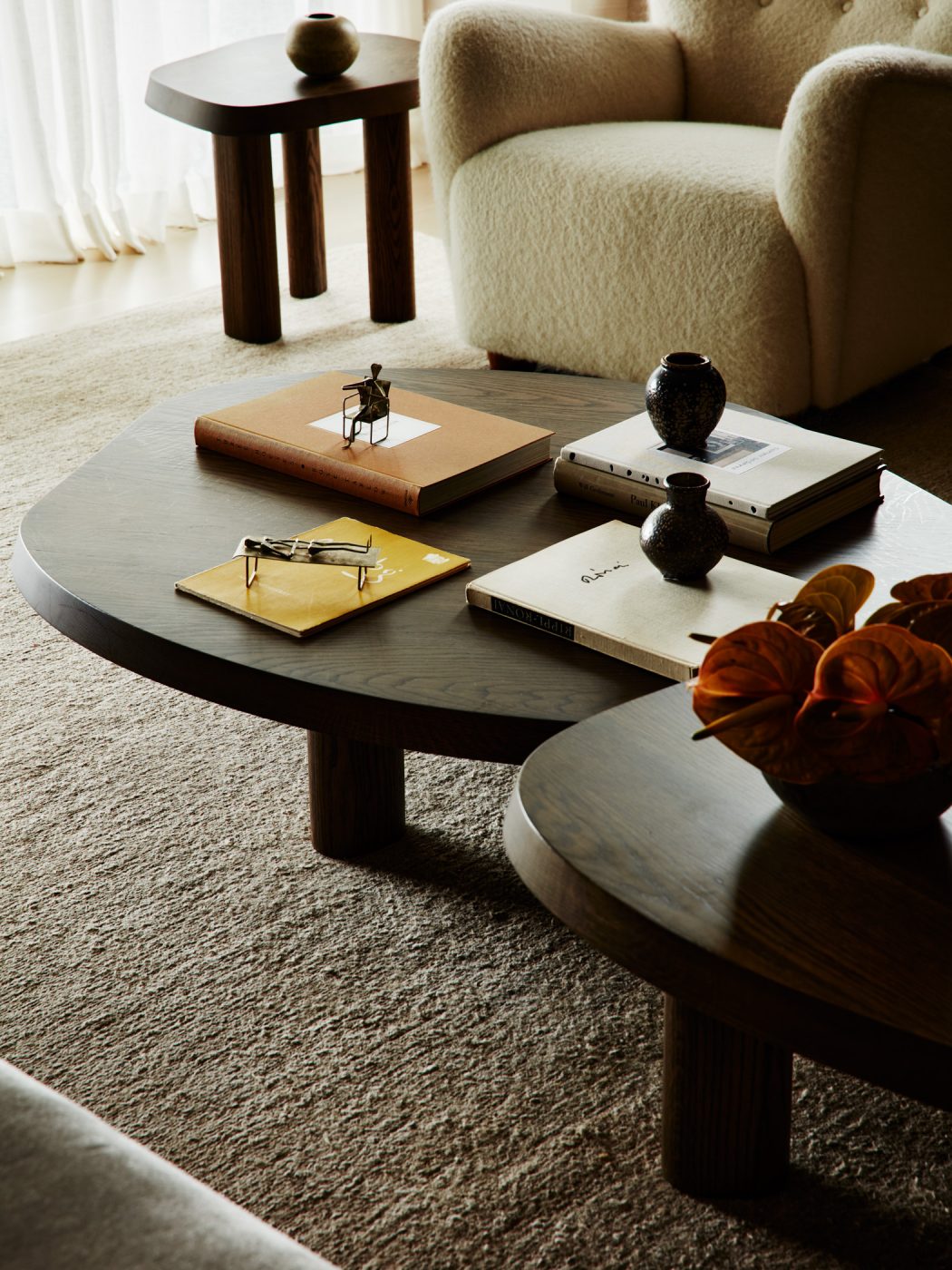
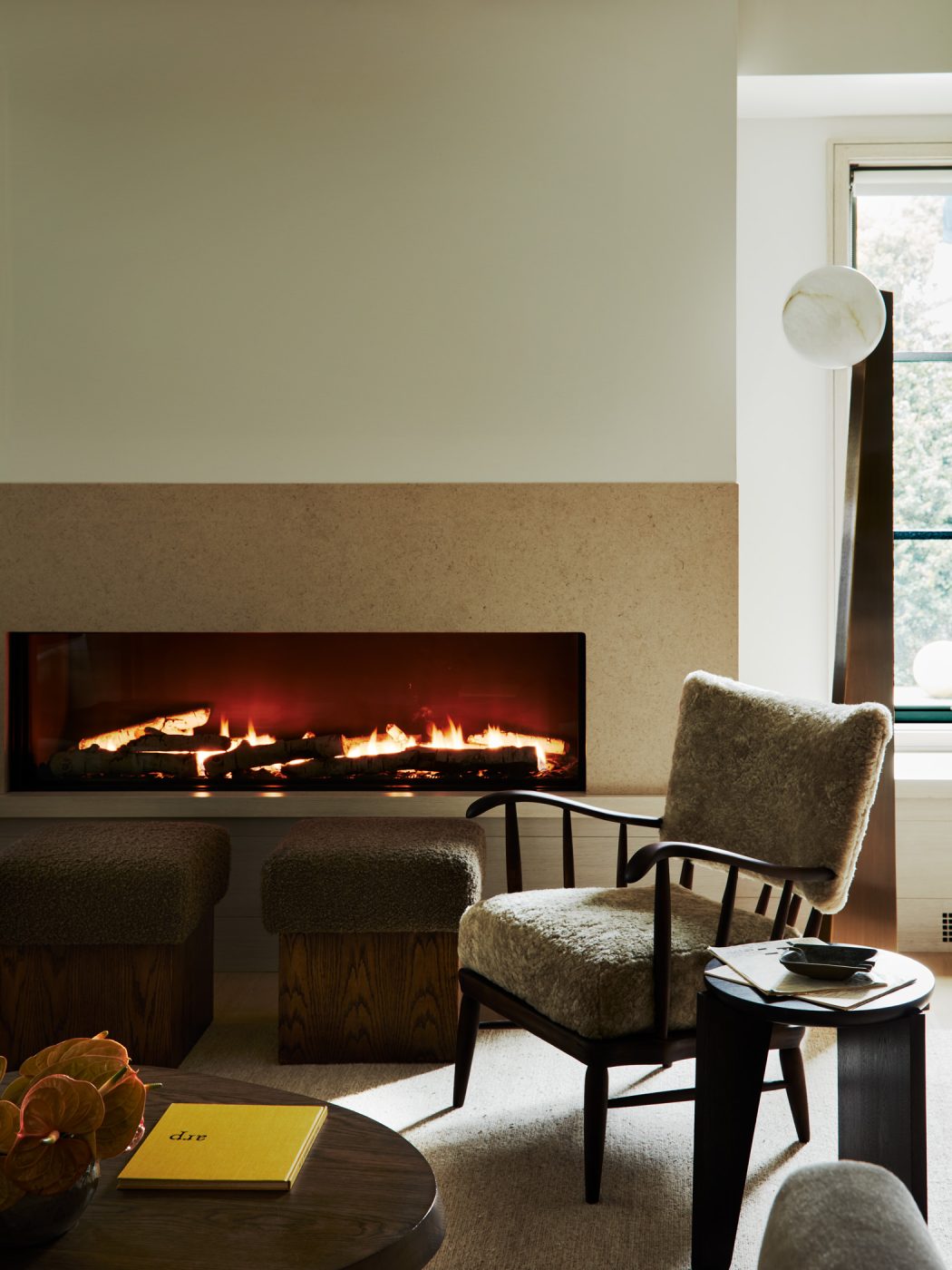
Moore says her directive from the clients was to create interiors with personality and refinement, while keeping everything comfortable and not too precious. The wife specifically requested very little color. “She really wanted it calming, a respite,” says Moore.
Throughout, the designer used a palette of warm, pale neutrals, with minimal pattern and lots of natural materials and rich, organic textures.
Her starting point was the living area, where she grouped a low-back sofa of her own design upholstered in a mohair velvet with a 1940s Flemming Lassen Tired Man wingback chair, sourced from 1stDibs and covered in cozy Pierre Frey Yeti fabric, plus a pair of vintage Møller & Stokke chairs that have what Moore describes as “the most beautiful patina on the arms. In a new build like this, vintage pieces bring in a lot of depth.”

The room’s creamy-white Nepalese carpet adds softness underfoot, while contrast is provided by several dark-wood pieces, including a vintage Charles Dudouyt Tripod table and an Egg Collective Wu side table. Another 1stDibs acquisition, a brass-and-alabaster floor lamp from Galerie Glustin Luminaires, and an array of ceramic vessels by contemporary makers like Philip Soucy contribute additional layers of materiality.
For the adjacent solarium-like dining space, Moore designed a sprawling table in ink-stained oak and a banquette, which borders two of its sides. The rest of the table is lined with cast-aluminum Giac armchairs that complement the banquette’s darkened-metal framework. A quietly sculptural Ladies & Gentlemen Studio pendant light hangs above. Moore kept the banquette’s profile low so as not to disrupt the views through the wraparound windows.

To honor the clients’ desire for calm, neutral surroundings, Moore limited the amount of art on the house’s walls, many of which she had finished in sumptuous plaster. She did bring in some noteworthy pottery works, including a Taylor Kibby ceramic wall sculpture in the entrance hall. Composed of ceramic links that resemble chain mail or a loosely knitted textile, the eye-catching piece is installed above a weathered-wood bench by Oda & King.
At the top of the entry’s floating staircase, a wall-spanning installation by artist Christina Watka animates the second-floor landing. From her series entitled “Murmurations,” the work is composed of an undulating swarm of small, hand-molded ceramic rounds, glazed with various pigments and shimmering metallics. “When the light turns in the evening, it hits right here, and the reflective pieces sparkle,” says Moore. “It feels almost like a light fixture in the sundown-dusk time. It’s really quite magical.”
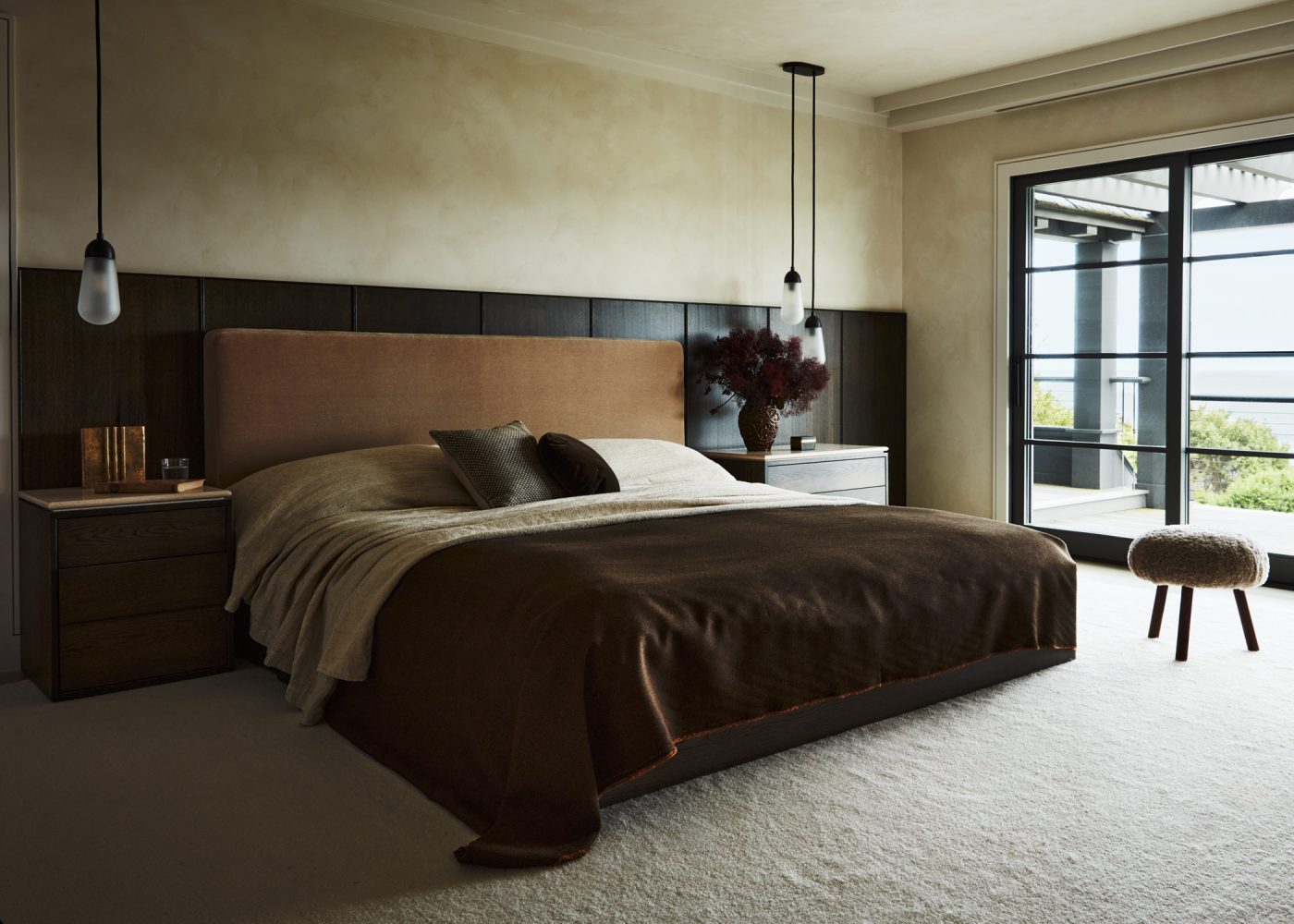
The serene, earthy vibe continues in the primary bedroom, where, behind the bespoke upholstered bed, Moore added wainscoting of dark-stained, rift-sawn oak that runs halfway up the wall of creamy plaster.
Bedside tables, designed by Moore in complementary oak with travertine tops, stand beneath Allied Maker pendant lights, while puffy Mario Bellini lounge chairs from the 1970s flank the room’s fireplace. The designer found the room’s Art Deco–style antiqued wall mirror on 1stDibs, which also provided the shearling-upholstered stool. A snowy alpaca rug offers another soft texture.

On the top floor, Moore outfitted the husband’s office with a custom adjustable desk, inspired by Pierre Jeanneret’s pigeonhole desks, that can be raised and used while standing. Open bookshelves loosely reminiscent of ones designed by Jeanneret’s occasional collaborator Jean Prouvé display ceramics and other objects. An Arne Jacobsen Egg chair and ottoman in soft leather compose a comfy spot for reading or rest. “He’s got this absolutely beautiful view of the water,” says Moore.
The wife’s multifunctional sacred space comprises an area for yoga and a cozy lounge that she can use for meditation or just relaxing. A quartet of Disc Interiors swivel chairs clad in a chocolate bouclé surround a circular coffee table atop another alpaca rug. A large glass-front iron cabinet, a flea-market find, displays her extensive collection of crystals. “I liked the juxtaposition of this industrial-feeling, not-precious cabinet holding these precious things,” says Moore.

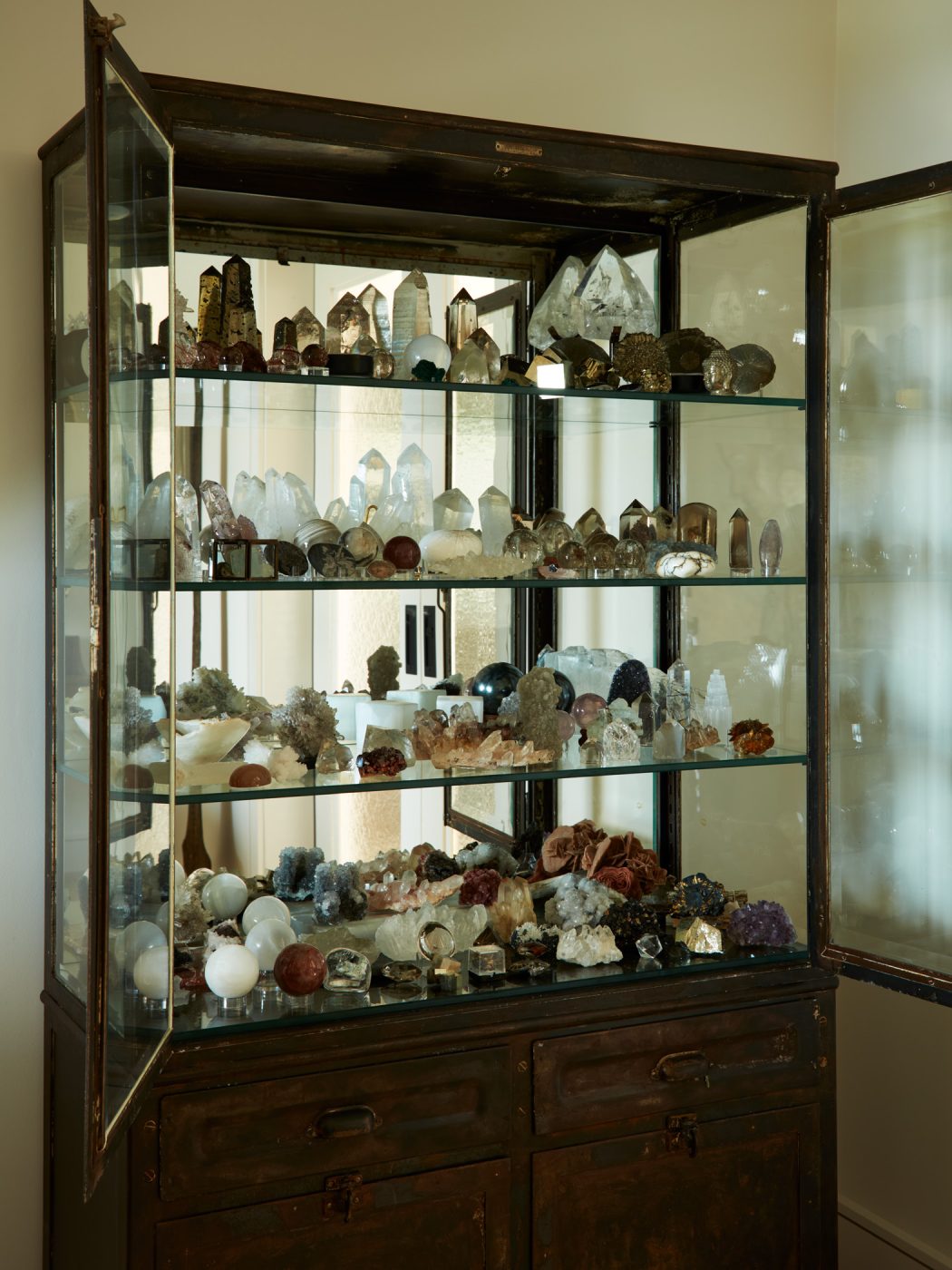
Dominating one wall is a painting of a female figure specially commissioned from artist Paul Meyer, who incorporated bits of crystal provided by the wife directly into the work. A number of the room’s other pieces came from 1stDibs, including a rosewood Scandinavian desk, where the wife occasionally makes jewelry; a Swedish Baroque chest of drawers; and a stoneware vase by Raquel Vidal and Pedro Paz.

“For me, it was really about the quality and patina of the pieces, the material, textural aesthetic,” Moore says of her approach to the room’s decor. “I wanted to keep it calm, soothing, natural.”
And there’s even a chic little Austrian rattan bar cart from the 1950s for when the mood calls for a different kind of transcendence. After all, who says a sacred space can’t make room for a stylish touch of the profane?

